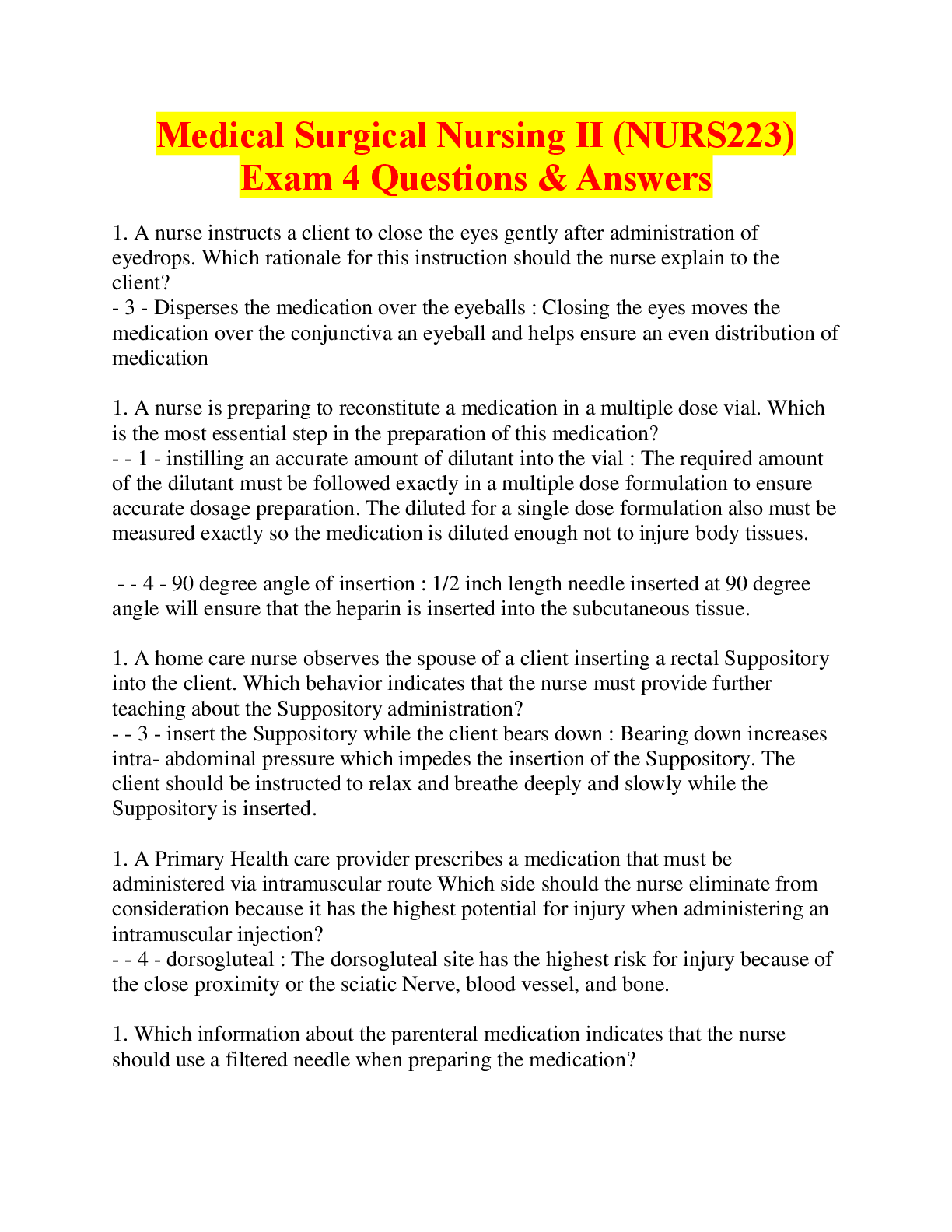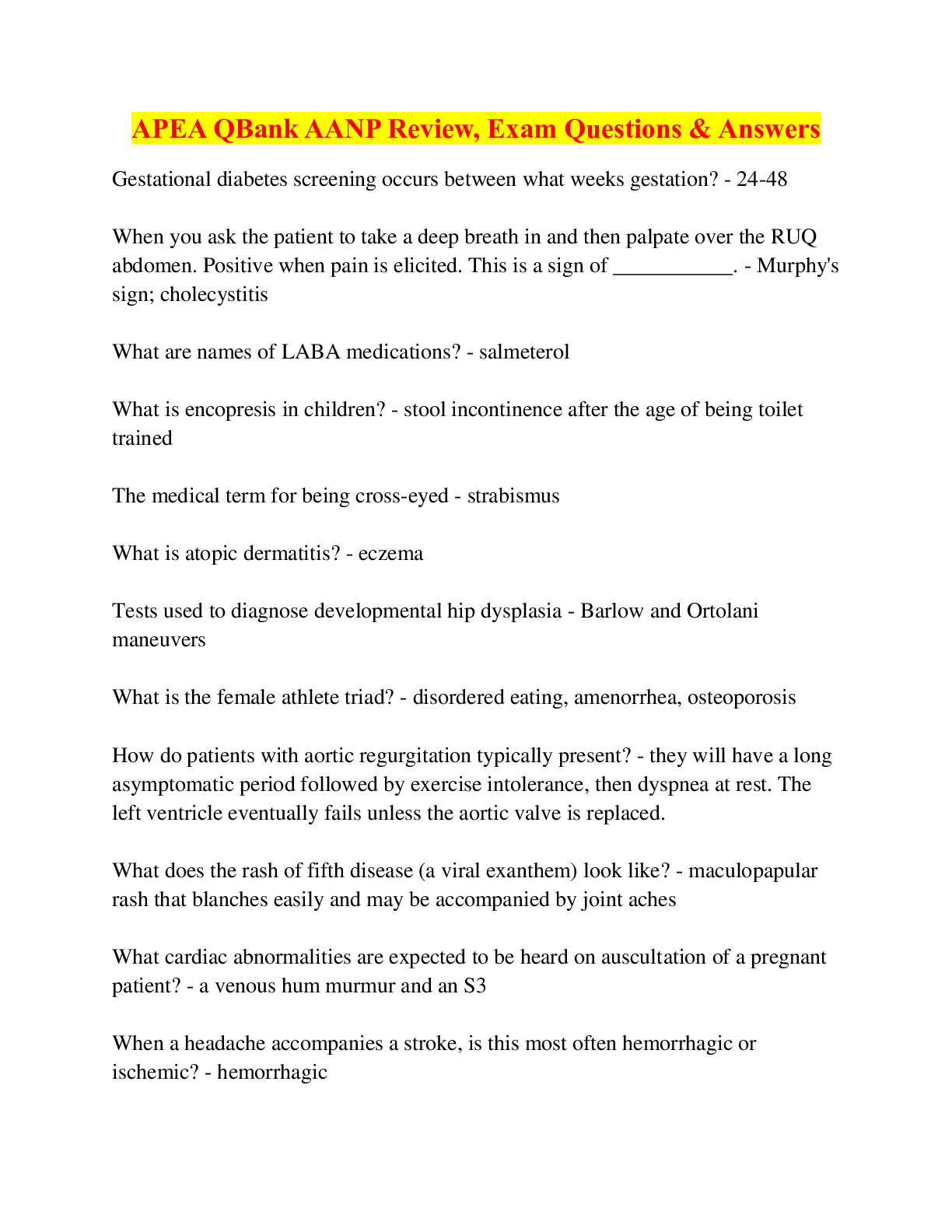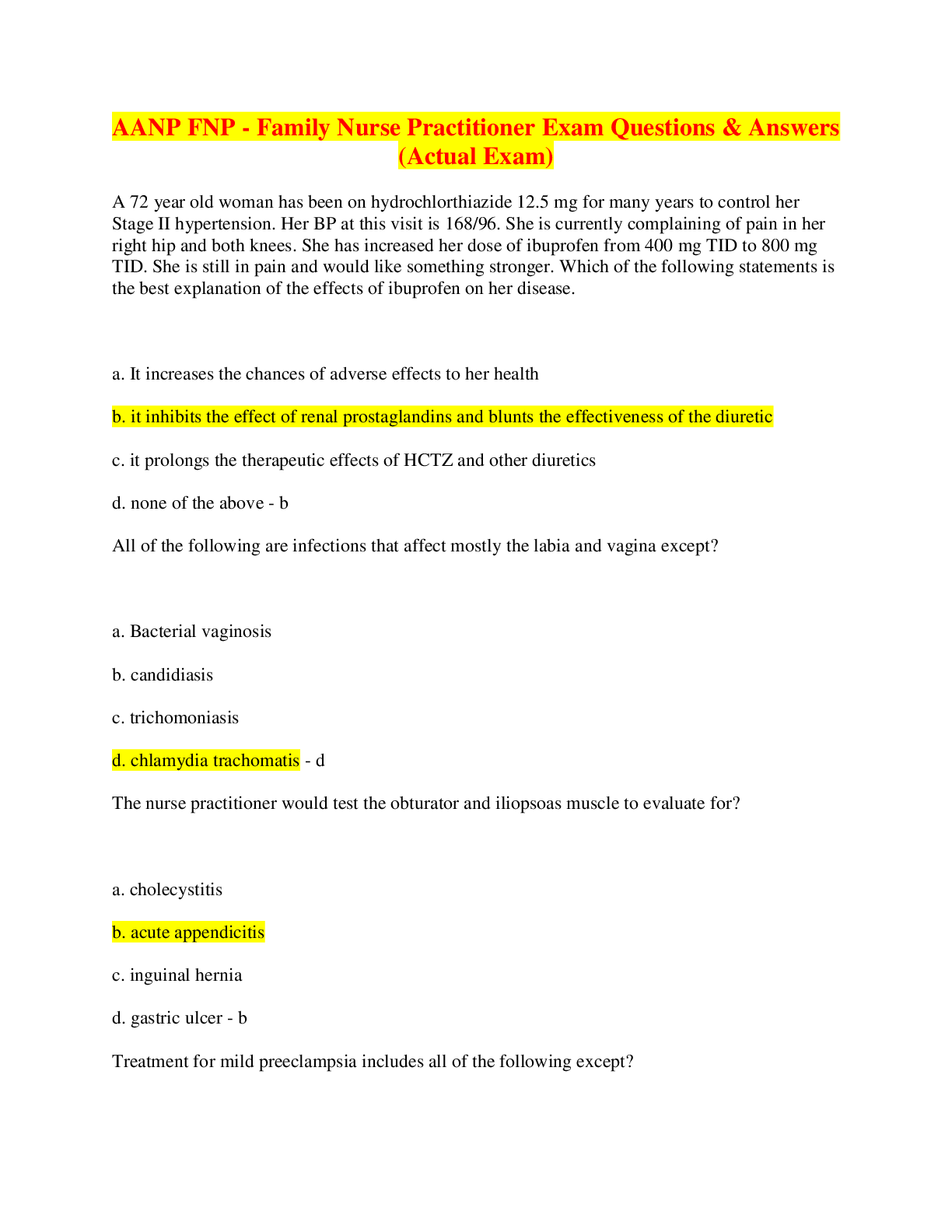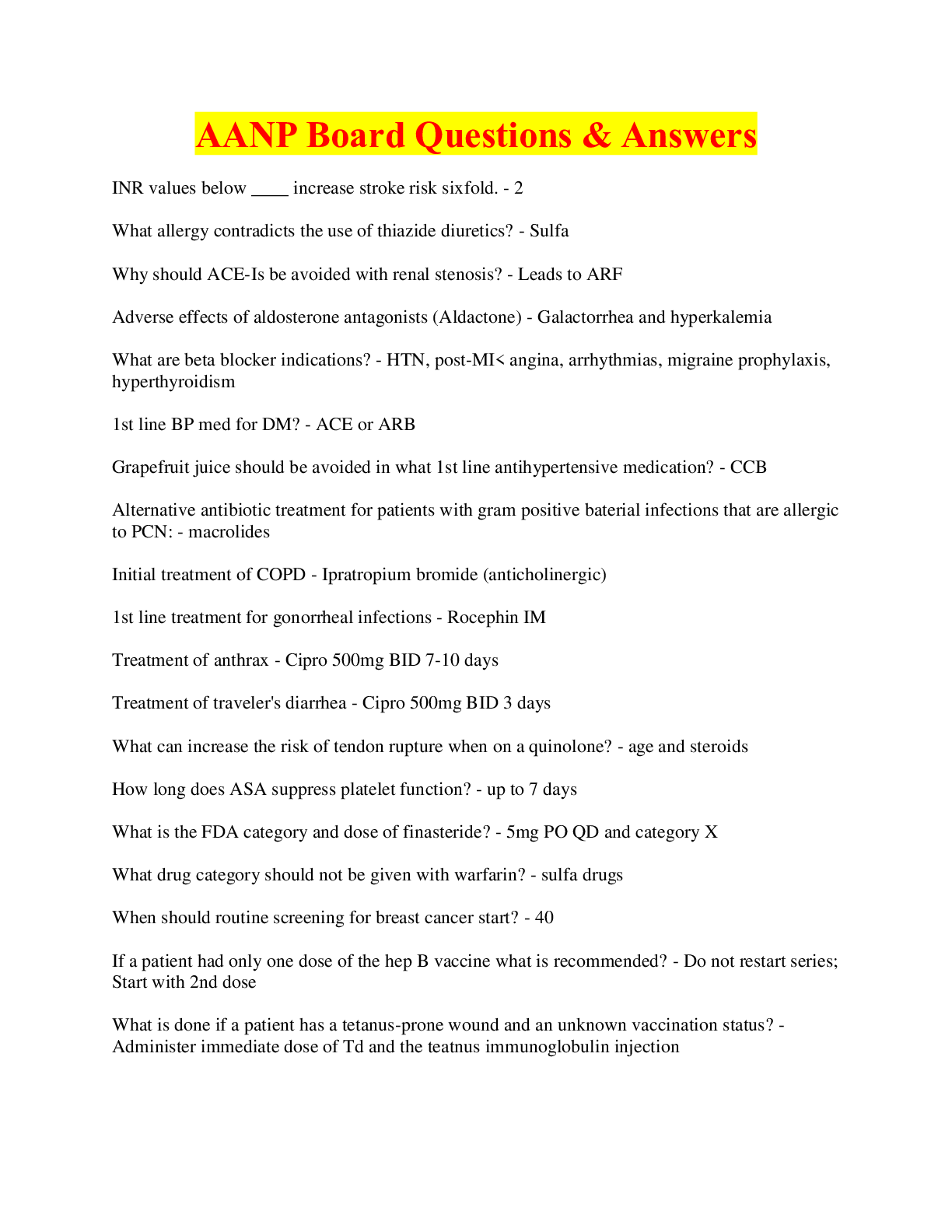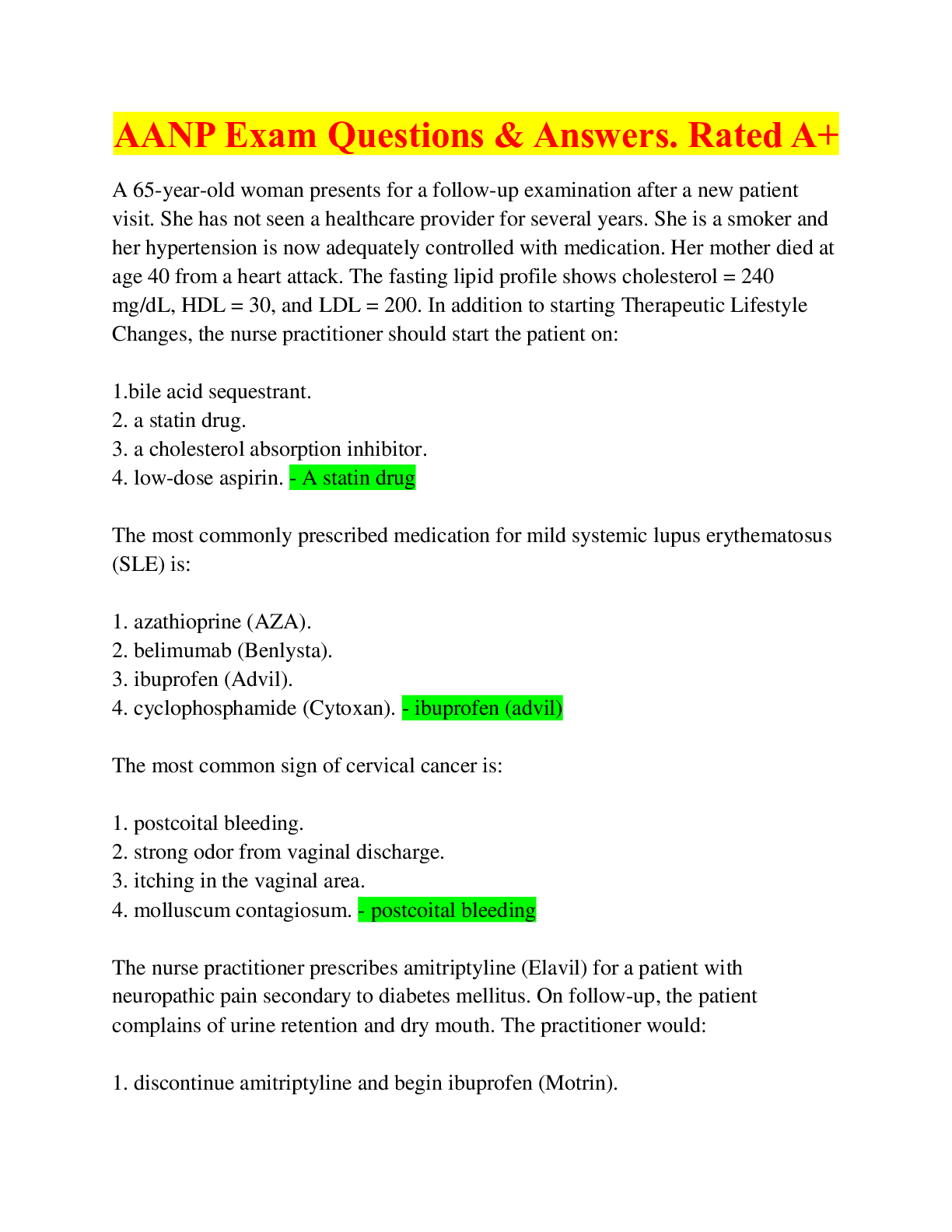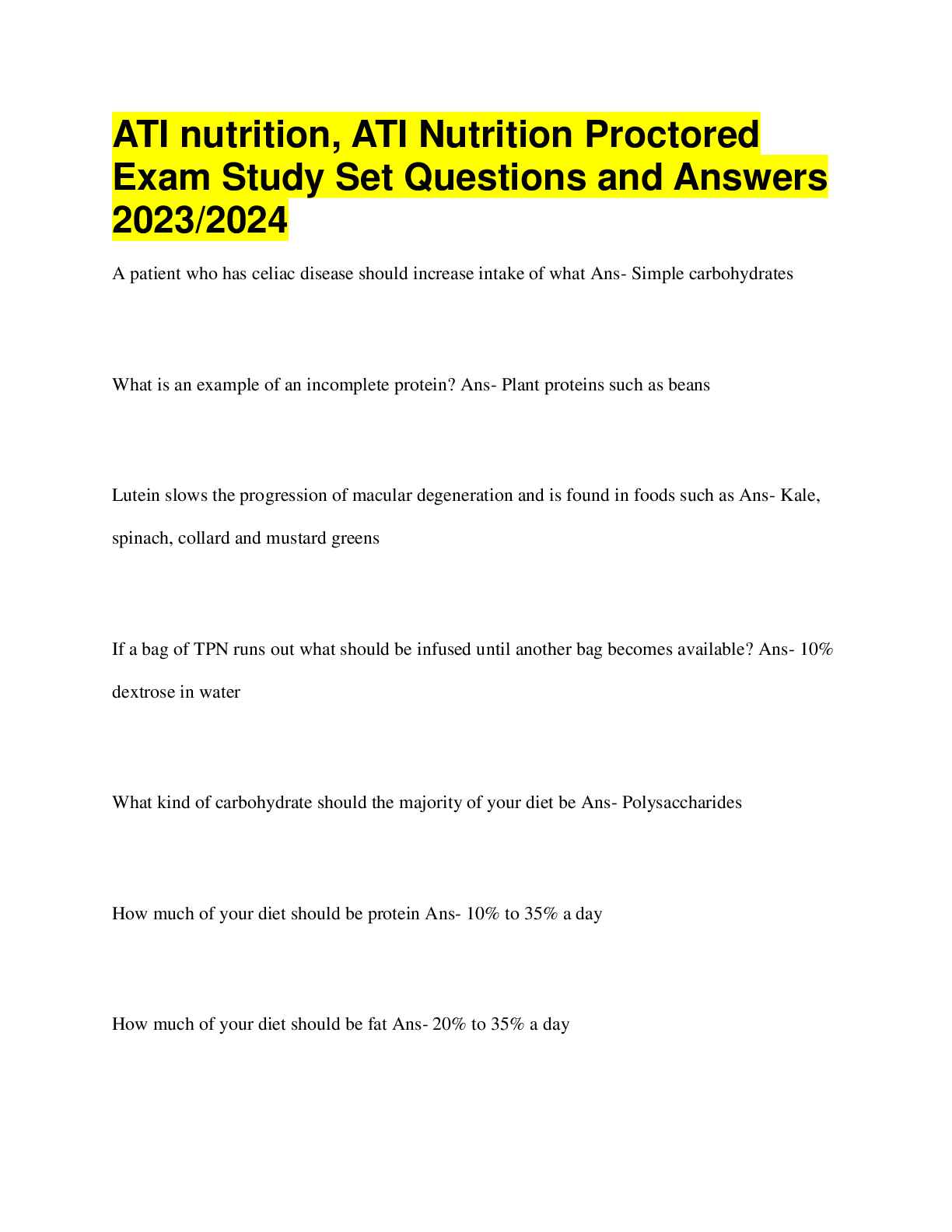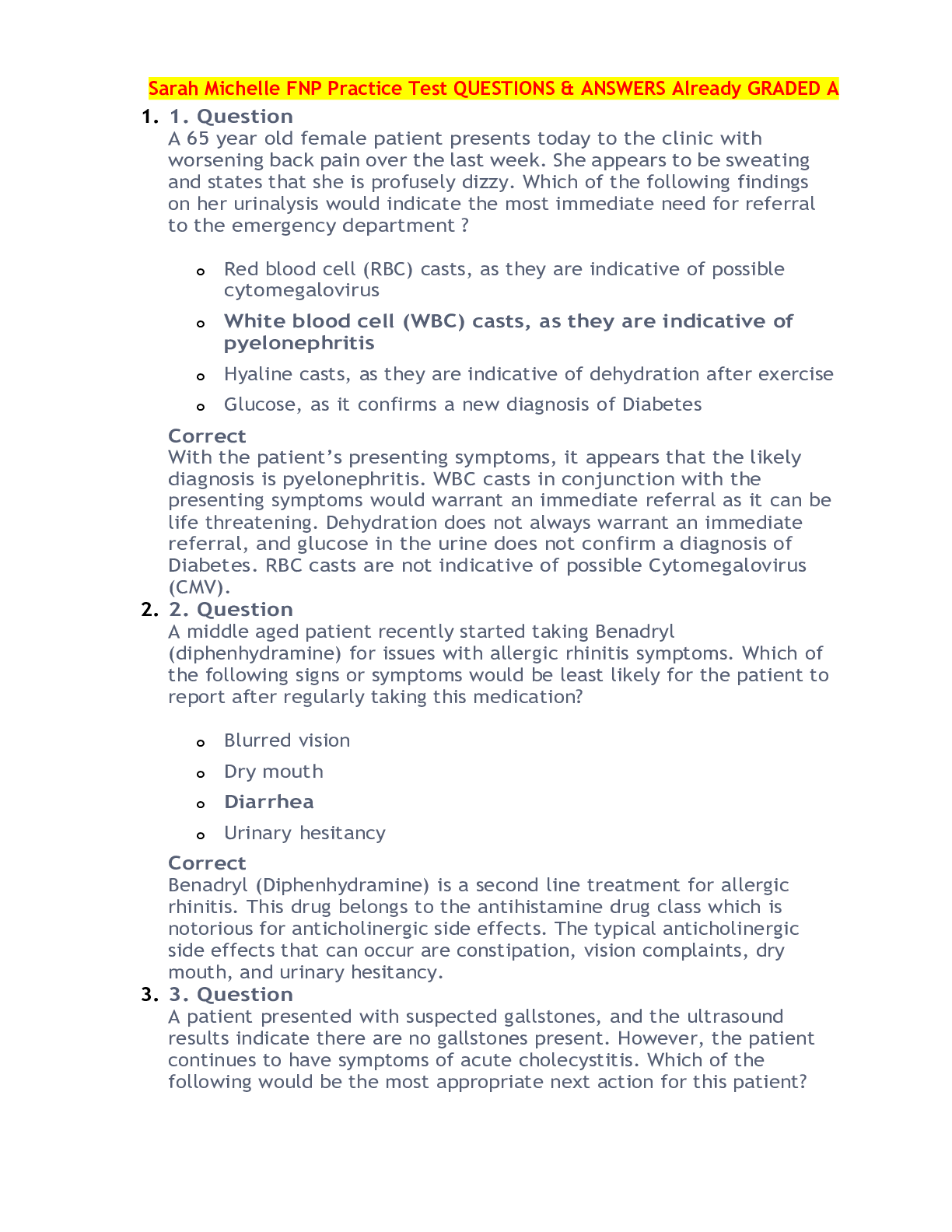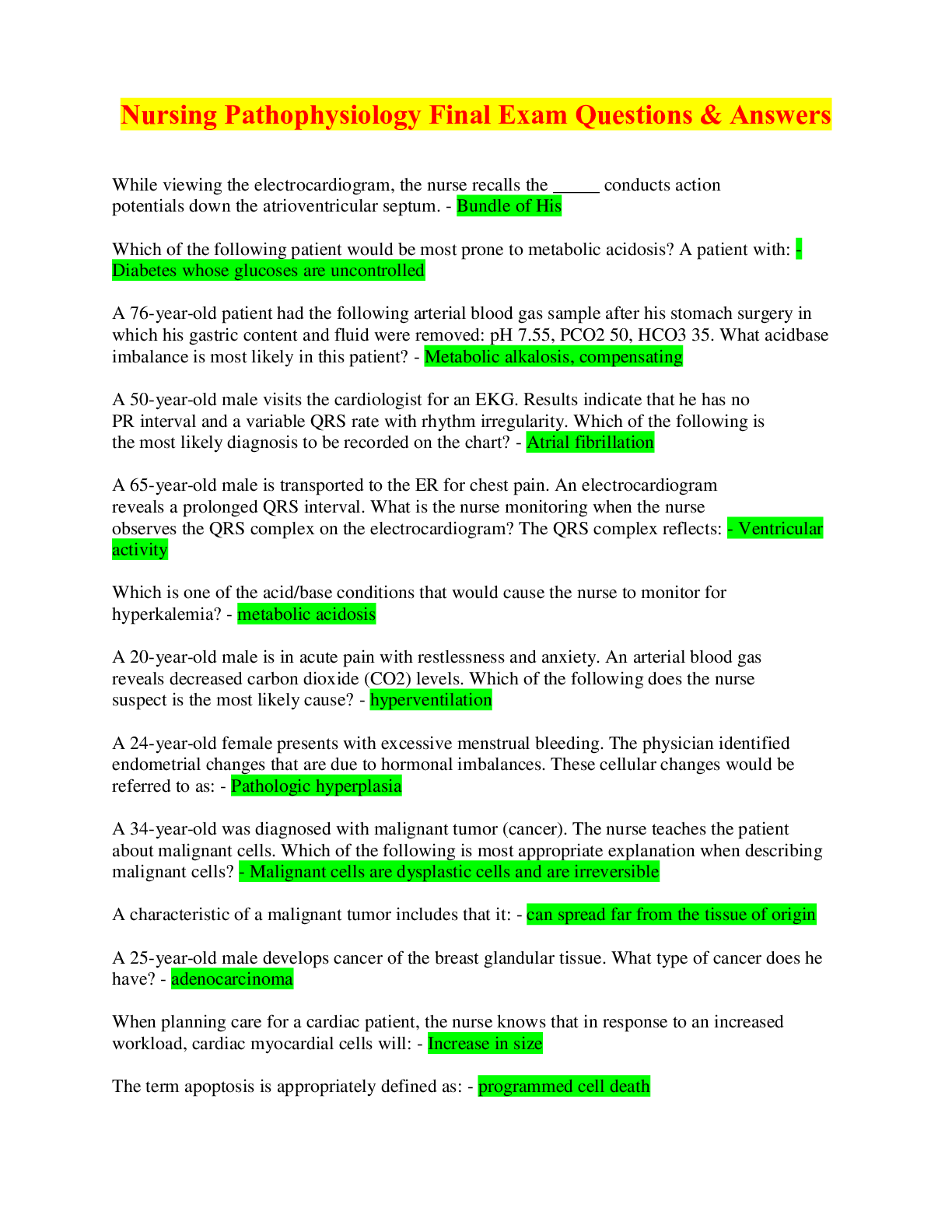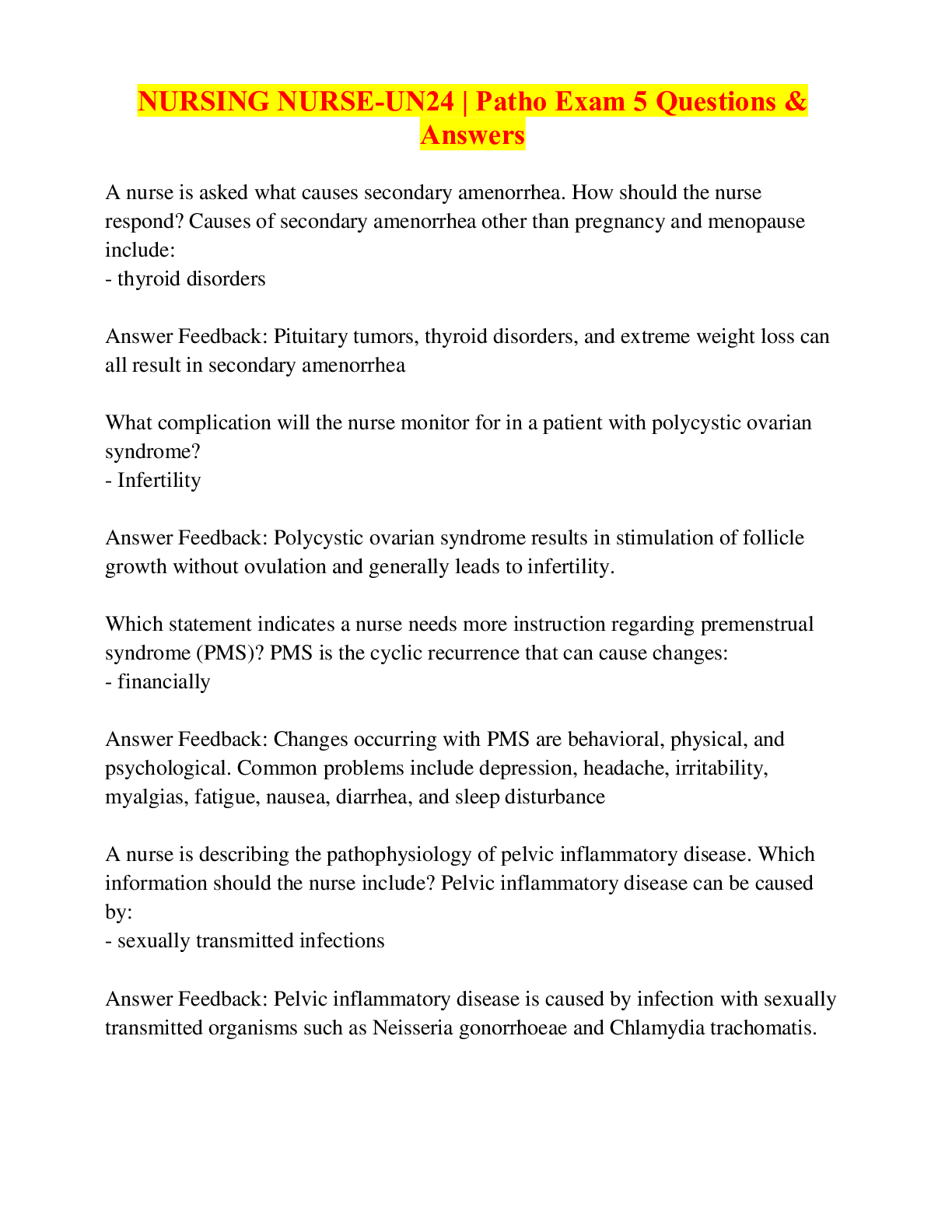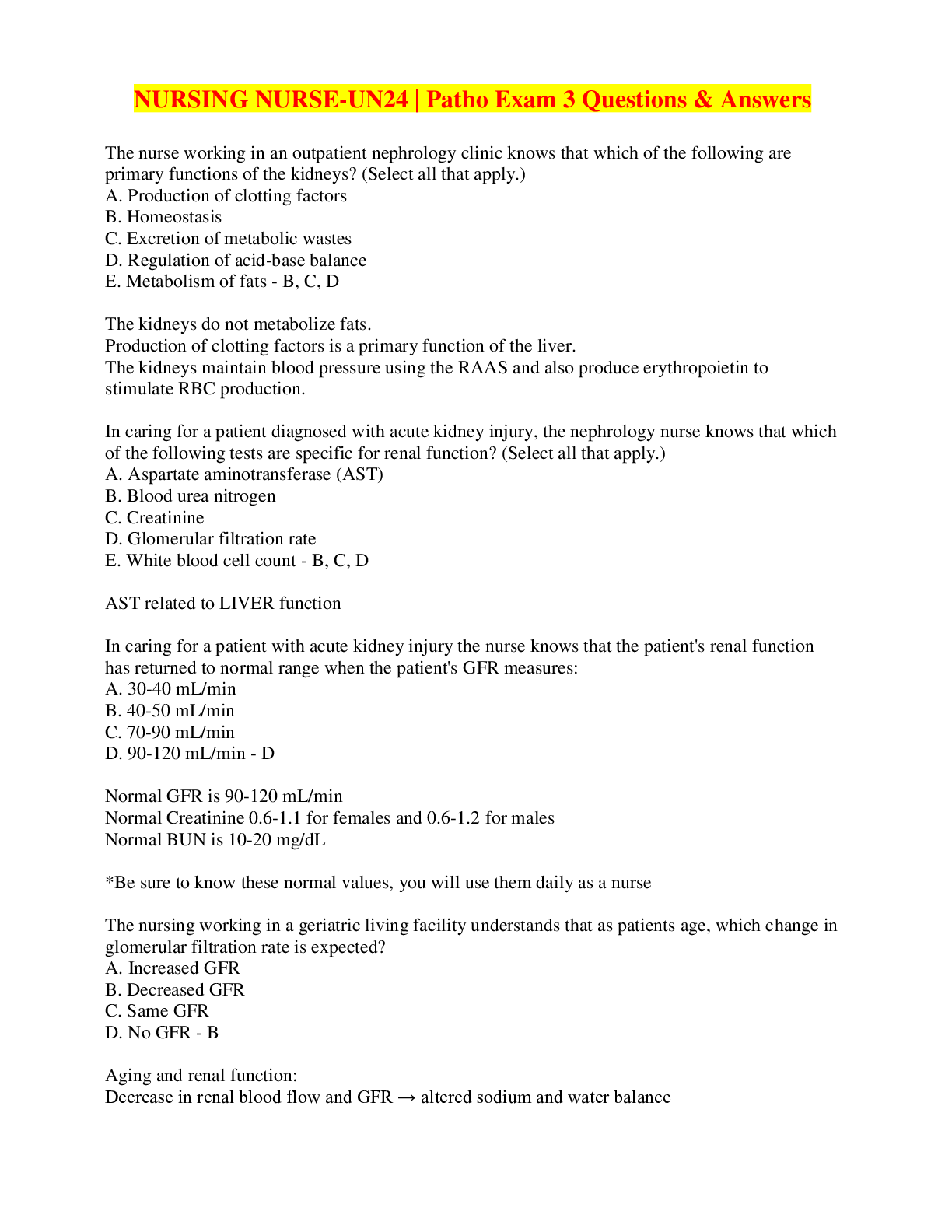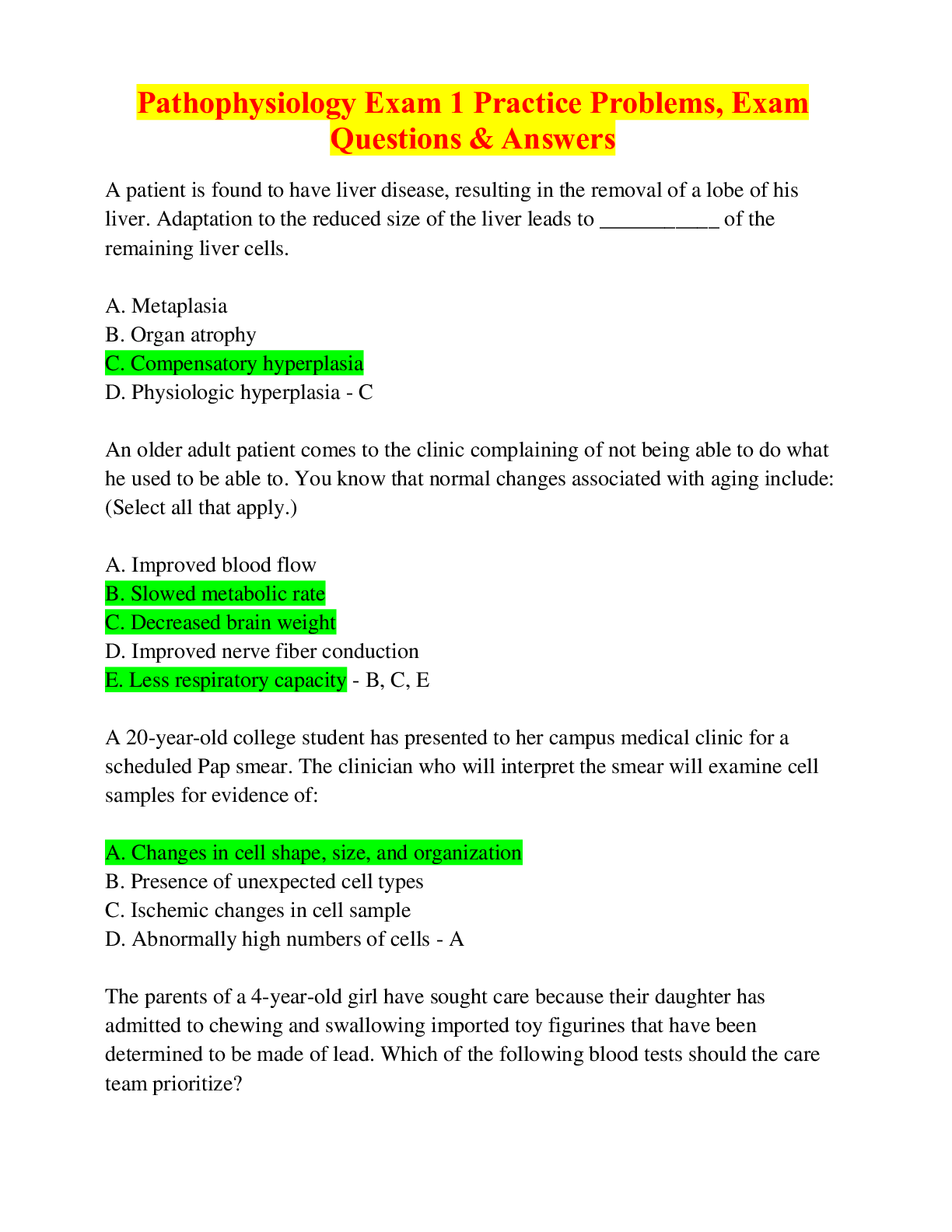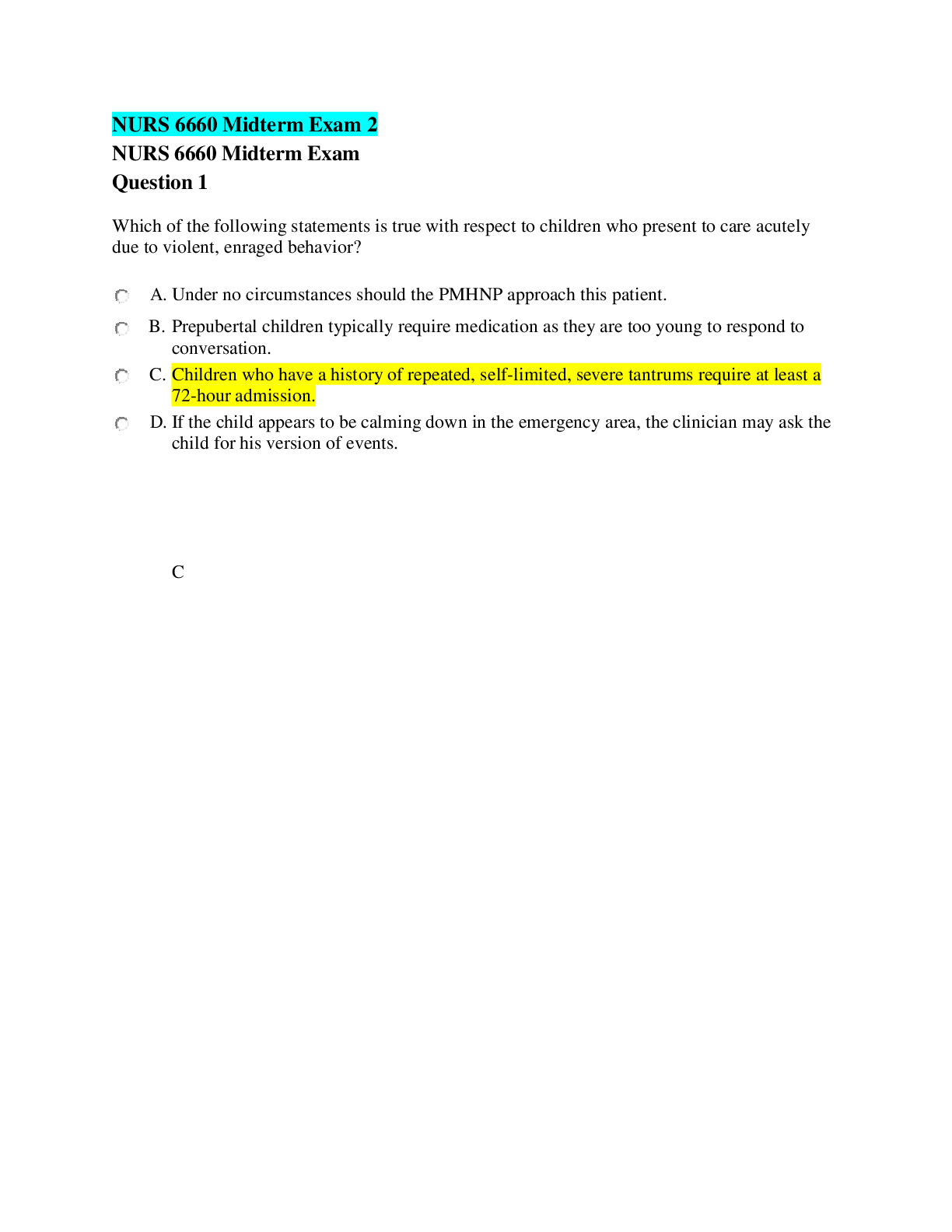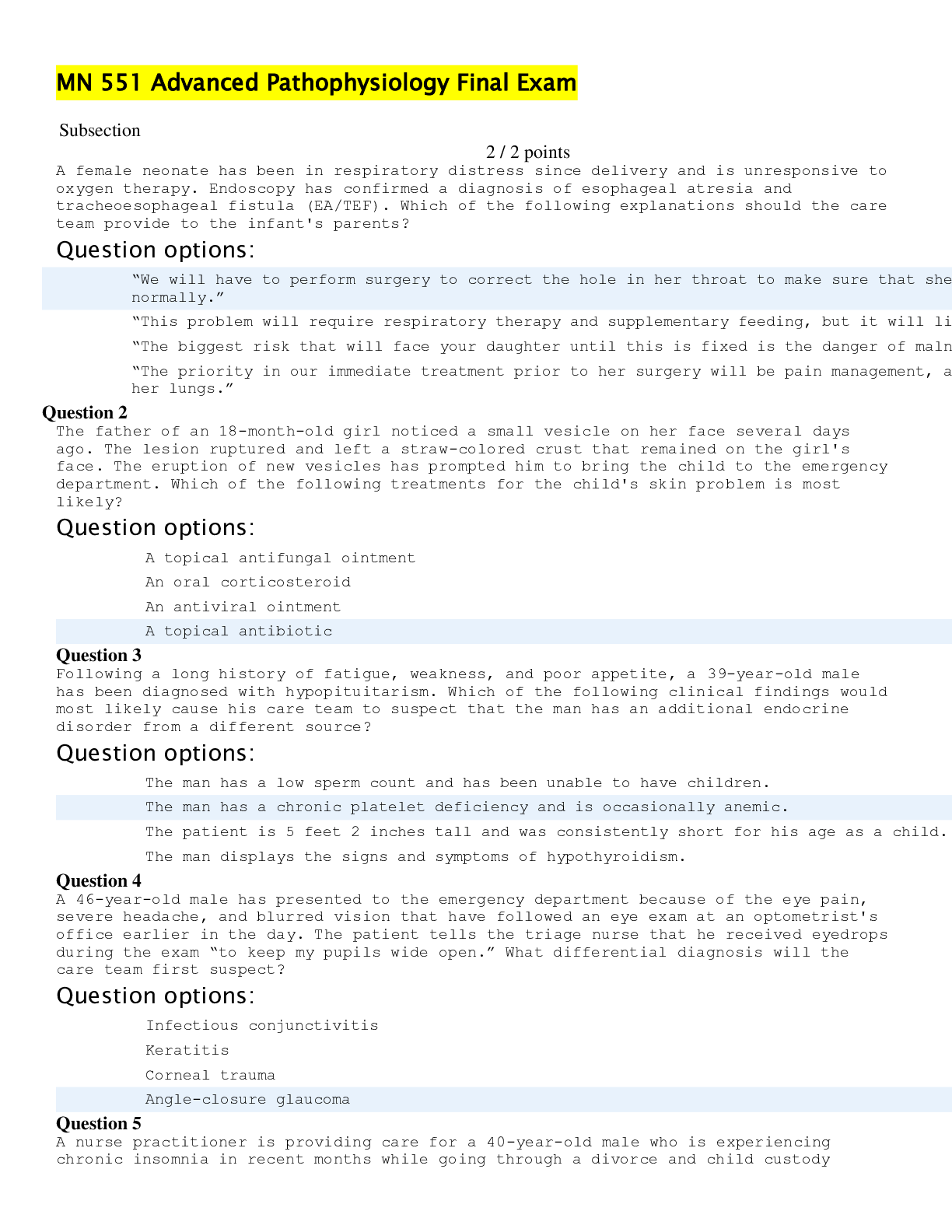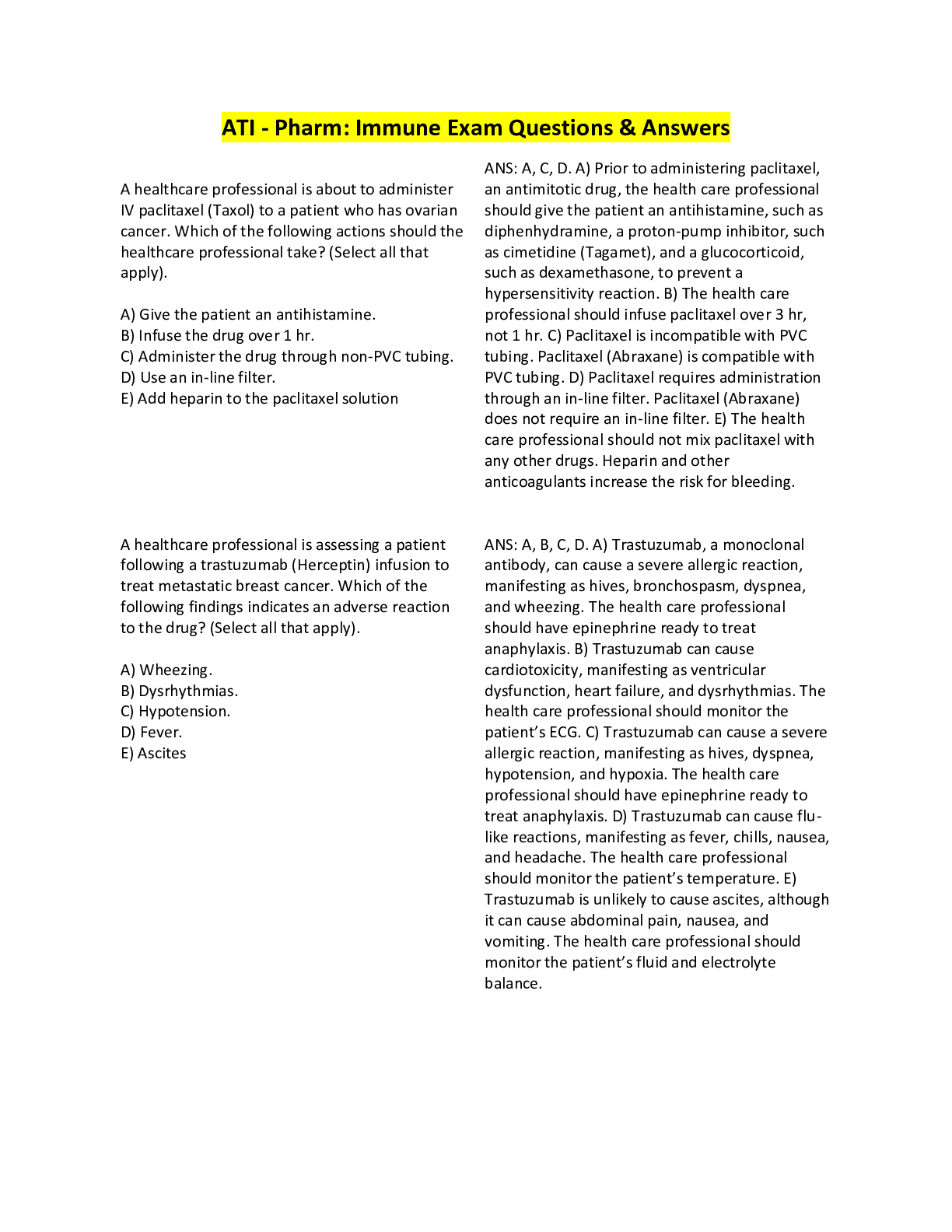NUR 305 Cumulative Final Exam Questions & Answers, Rated 100%
Document Content and Description Below
NUR 305 Cumulative Final Exam Questions & Answers, Rated 100%-Which symptom requires immediate intervention during a hypoglycemic episode? A.Confusion B.Hunger C.Headache Tachycardia - CONFUSION... Rationale: Glucose is necessary for brain function. Confusion is a marker of severe hypoglycemia requiring immediate intervention. Irritability/anxiety, hunger, tachycardia, headache, sweating, and seizures are additional signs of hypoglycemia. When should a patient with type 1 diabetes avoid exercise? A.When serum glucose is less than 150 B.During colder months C.When ketones are present in the urine D.When emotional stressors are high for the patient - C.When ketones are present in the urine Rationale: Exercise should be avoided if ketones are present in the urine. Ketones indicate that current insulin levels are not adequate and that exercise would elevate blood glucose levels. A patient with an acid-base imbalance has an altered potassium level. The nurse recognizes that the potassium level is altered because: 1. Potassium is returned to extracellular fluid when metabolic acidosis is corrected. 2. Hyperkalemia causes an alkalosis that results in potassium being shifted into the cells. 3. Acidosis causes hydrogen ions in the blood to be exchanged for potassium from the cells. 4. In alkalosis, potassium is shifted into extracellular fluid to bind excessive bicarbonate. - 3. Acidosis causes hydrogen ions in the blood to be exchanged for potassium from the cells. Rationale: Changes in pH (hydrogen ion concentration) will affect potassium balance. In acidosis, hydrogen ions accumulate in the intracellular fluid (ICF), and potassium shifts out of the cell to the extracellular fluid to maintain a balance of cations across the cell membrane. In alkalosis, ICF levels of hydrogen diminish, and potassium shifts into the cell. If a deficit of H+ occurs in the extracellular fluid, potassium will shift into the cell. Acidosis is associated with hyperkalemia, and alkalosis is associated with hypokalemia. A patient has the following arterial blood gas (ABG) results: pH 7.48, PaO2 86 mm Hg, PaCO2 44 mm Hg, HCO3 29 mEq/L. When assessing the patient, the nurse would expect the patient to experience: 1. Warm, flushed skin. 2. Respiratory rate of 36. 3. Blood pressure of 94/52. 4. Hypertonic muscles with cramping. - 4. Hypertonic muscles with cramping. Rationale: The patient is experiencing metabolic alkalosis (elevated pH and elevated HCO3). Clinical manifestations of metabolic alkalosis include hypertonic muscles and cramping, severe hypotension and reduced respiratory rate. Hypotension and warm, flushed skin may occur with respiratory acidosis. A patient is brought to the ED after being hit by a car while biking. He is unresponsive, has shallow breathing, and has an open femur fracture from which he has lost a significant amount of blood. The nurse anticipates which acid-base imbalance? A.Metabolic alkalosis B.Respiratory acidosis C.Metabolic alkalosis and respiratory alkalosis D.Metabolic acidosis and respiratory acidosis - D.Metabolic acidosis and respiratory acidosis Rationale: Hypoperfusion associated with significant shift in intravascular volume and/or blood loss that may be experienced by patients with significant trauma, burn injuries, sepsis, shock states, or cardiac arrest are examples of problems leading to metabolic acidosis. Shallow breathing or ineffective ventilation causes respiratory acidosis. Combined acidosis is more severe than either metabolic acidosis or respiratory acidosis alone. The nurse is evaluating the laboratory work of a patient who has uncontrolled metabolic acidosis. Which outcome would result from this condition? A.pH 7.30 B.Bicarbonate 18 mEq/L C.Pao2 98 mm Hg D.Serum potassium 5.7 mEq/L - D.Serum potassium 5.7 mEq/L Rationale: Metabolic acidosis is reflected by several changes in ABG values. The pH is low (<7.35). The bicarbonate level is low (<21 mEq/L). The partial pressure of arterial oxygen (Pao2) is normal because gas exchange is adequate. The serum potassium level is often high in acidosis as the body attempts to maintain electroneutrality during buffering. The nurse is reviewing the standing orders for a patient who was admitted for evaluation of chest pain. The patient has a history of chronic obstructive pulmonary disease (COPD), and his laboratory results and assessment reveal that he has mild respiratory acidosis. The nurse would question which order? A.Encourage oral fluids B.Oxygen therapy at 4 L/min as needed C.Keep head of bed elevated Bedrest with bathroom privileges only - B.Oxygen therapy at 4 L/min as needed Rationale: The bedrest order will help the patient conserve energy. The upright position (mid-Fowler's to high-Fowler's position) helps increase lung expansion. Increasing fluid intake may reduce the thickness of lung secretions and assist in their removal. Oxygen therapy helps promote gas exchange for patients with respiratory acidosis. However, use caution when giving oxygen to patients with COPD and CO2 retention as evidenced by a high Paco2 level. The only breathing trigger for these patients is a decreased arterial oxygen level. Giving too much oxygen to these patients decreases their respiratory drive and may lead to respiratory arrest Ideally, the goal of patient diabetes education is to: 1. Make all patients responsible for the management of their disease. 2. Involve the patient's family and significant others in the care of the patient. 3. Enable the patient to become the most active participant in the management of the diabetes. 4. Provide the patient with as much information as soon as possible to prevent complications of diabetes. - 3. Enable the patient to become the most active participant in the management of the diabetes. Rationale: The goal of diabetes education is to enable the patient to become the most active participant in his or her own care. A patient with type 1 diabetes calls the clinic with complaints of nausea, vomiting, and diarrhea. It is most important that the nurse advise the patient to: 1. Hold the regular dose of insulin. 2. Drink cool fluids with high glucose content. 3. Check the blood glucose level every 2 to 4 hours. 4. Use a less strenuous form of exercise than usual until the illness resolves. - 3. Check the blood glucose level every 2 to 4 hours. Rationale: If a person with type 1 diabetes mellitus is ill, he or she should test blood glucose levels at least at 2-to-4-hour intervals to determine the effects of this stressor on the blood glucose level. Cardiac monitoring is initiated for a patient in diabetic ketoacidosis. The nurse recognizes that this measure is important to identify: 1. Dysrhythmias resulting from hypokalemia. 2. Fluid overload resulting from aggressive fluid replacement. 3. The presence of hypovolemic shock related to osmotic diuresis. 4. Cardiovascular collapse resulting from the effects of excess glucose on cardiac cells. - 1. Dysrhythmias resulting from hypokalemia. Rationale: Electrolytes are depleted in diabetic ketoacidosis. Osmotic diuresis occurs with depletion of sodium, potassium, chloride, magnesium, and phosphate. Hypokalemia may lead to ventricular dysrhythmias such as premature ventricular complexes and bradycardia The daughter of a patient with early familial Alzheimer's disease (AD) asks how AD can be detected. The nurse describes early warning signs of AD, including: 1. Forgetting a colleague's name at a party. 2. Repeatedly misplacing car keys or a wallet. 3. Leaving a pot on the stove that boils dry and burns. 4. Having no memory of preparing a meal and forgetting to serve or eat it. - 4. Having no memory of preparing a meal and forgetting to serve or eat it. Memory loss that affects job skills: Frequent forgetfulness or unexplainable confusion at home or in the workplace may signal that something is wrong. This type of memory loss goes beyond forgetting an assignment, a colleague's name, a deadline or phone number. Difficulty performing familiar tasks: people with AD may cook a meal but then forget not only to serve it but also that they cooked it. Misplacing things: temporarily misplacing keys, purses, wallets is a normal albeit frustrating event. Persons with AD may put items in inappropriate places but have no memory how they got there (ie. eating utensils in clothing drawers) [Show More]
Last updated: 7 months ago
Preview 5 out of 35 pages

Loading document previews ...
Buy this document to get the full access instantly
Instant Download Access after purchase
Buy NowInstant download
We Accept:

Reviews( 0 )
$13.50
Can't find what you want? Try our AI powered Search
Document information
Connected school, study & course
About the document
Uploaded On
Dec 18, 2024
Number of pages
35
Written in
Additional information
This document has been written for:
Uploaded
Dec 18, 2024
Downloads
0
Views
7

